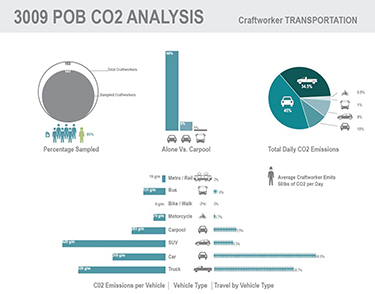|
Subscribe / Renew |
|
|
Contact Us |
|
| ► Subscribe to our Free Weekly Newsletter | |
| home | Welcome, sign in or click here to subscribe. | login |
Environment
| |
 |
September 25, 2014
Being green is not just about checking boxes
Skanska USA

Smedley
|
Sustainability in the construction industry is an interesting paradigm.
The building sector is inarguably one of the largest users and abusers of materials and resources, both in construction and operations. But the role of the contractor in a project’s sustainable strategies and solutions is typically that of implementer, not innovator.
In most cases, due to market drivers or procurement methods, the contractor is not in the driver’s seat — and oftentimes not even a passenger — when it comes to informing the early design choices that guide a building’s sustainable approach.
When asked what their role is in the sustainability of the buildings they construct, most contractors would unfortunately answer that “it’s not our decision.”
At Skanska, we believe that part of our responsibility as a contractor is to recognize the environmental challenges and opportunities we face on every project, and find innovative and leading approaches that allow us to be part of a project’s green success story.
A few key steps over the past few years in this regard have resulted in giant leaps in a few categories, and have helped the company expand the role of the contractor in the journey toward sustainable solutions on all of our projects.
1. Be a leader instead of a follower (or an innovator instead of a reactor).
Our first leap was to provide preconstruction and construction services for what was to become the fourth certified Living Building in the world, the Bertschi School Living Science Building in Seattle.
Beyond the unknowns around many of the requirements of the Living Building Challenge at the time, the team was also donating its time to the effort. It was an opportunity to gain knowledge and experience by creating a built research project, in a way.
Skanska led the materials research effort, which met the Living Building Challenge’s progressive materials red list, appropriate sourcing, FSC-Certified Wood and construction waste management requirements.
What resulted was a cohesive, dedicated team that gained the experience of designing and constructing a living building and understood the risks and opportunities it offered for projects. Skanska is applying this experience and understanding on current projects with high sustainability goals, using the Living Building Challenge framework as one way to assess green strategies and solutions.
The experience also allowed Skanska to participate in Living Building Challenge projects across the country, because we were one of the early adopters.
2. Provide out-of-the-box services and tools.
Skanska’s second leap was to commit to carbon footprint tracking on its three development projects in Seattle.
There are various tools out there to assist in quantifying and tracking the carbon impact of products based on their composition and the locations where their materials are extracted and assembled. Skanska developed its own material tracking spreadsheet, using carbon information from various industry tools.
Information on products is collected and logged during construction, so at the end of the project there is a comprehensive carbon assessment available. The impact of transit to and from the project site for all craft workers is also tracked in an effort to understand where people are coming from and how they are traveling to work.
The outcome is a database of typical construction materials used in projects — concrete, steel, glass and wood — with the embodied carbon associated with their manufacture, transport and installation. Various manufacturers of a specific product can be compared for impact. This information will be available to our project owners and design teams, so they can weigh the carbon footprint of a material as part of the design phase.
Skanska also compares carbon impact of its various projects and uses data to understand why one project is producing less carbon than another. These assessments will help to reduce carbon emissions and production during construction of future Skanska projects.
3. Look forward instead of backwards.
There is a current mindset of relying on environmental certifications to tell a building’s sustainability story. Built Green and LEED are the front-runners in terms of certification languages that most have become fluent in, or can at least understand. Other certifications such as the Living Building Challenge and the Well Building Standard are emerging as alternative paths to creating a sustainable building.
With so many options available — all with different metrics — a project can easily become the victim of standards fatigue or information overload, where the goal becomes simply checking boxes to reach a certain level of green. On the other end, a team may opt out of certification altogether because the choices and options become overwhelming.
Skanska is developing a process to help projects assess their level of green based on specific goals and values. Sustainable strategies would be developed and weighed against how they help support project values prior to using a rating system checklist, to allow the team to focus on finding holistic, project-based sustainable solutions without the noise of how many points or stars it achieves.
Applying these three categories of thought to sustainability has provided Skanska a path to increasing our knowledge, capacity and opportunity to be a part of the conversation earlier in a project’s life. We have learned that the contractor can be a project’s builder as well as design participant, if the effort is applied to gain knowledge and experience necessary to bring unique and innovative green solutions to the table.
The work has only just begun. We know there is much more to learn and do.
Stacy Smedley is a preconstruction manager for sustainability at Skanska USA, providing strategic guidance across Skanska projects in the Seattle area. Smedley came to Skanska from KMD Architects, where she was the project manager for the extension of the Bertschi School Science Wing. She is also the founder of local nonprofit The SEED Collaborative.
Other Stories:
- Passive House finds a permanent home in the Northwest
- Survey: Landau Associates
- Survey: HWA GeoSciences
- Survey: Eco Chemical
- Survey: Environmental Resources Management
- Survey: WISErg Corp.
- Survey: Environmental Sciences Associates
- Survey: Farallon Consulting
- These modular classrooms are not old school
- Local firms invent modules to protect Louisiana coast
- Old mining pond becomes new salmon habitat
- Time to jump on contaminated urban properties?
- Tackling toxics with green chemistry
- How biosolids can curb greenhouse gases
- Lower Duwamish: watershed management poster child?
- Is hard water drowning Eastern Washington’s economy?
- Preserving Seattle’s largest forest takes a group effort
- Carbon-rich tidal wetlands down, but not out
- Survey: Herrera Environmental Consultants



